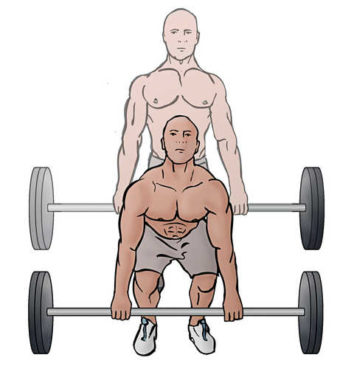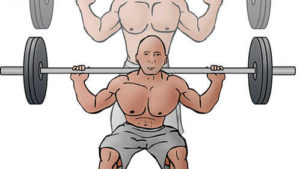
More strength is the foundation of more muscle and there’s nothing better than the barbell squat, barbell deadlift and barbell bench press for building strength and whole body muscle mass. These lifts are the currency of the sport of powerlifting. Powerlifters deal in the ‘one rep max’ in competition, executing one single heaviest rep in each of the three lifts in order to build a winning combined ‘total’ of weight lifted through that day. It’s about attitude and hard work and, crucially, polished technique.
If you think of a typical overweight, lumbering, sweaty powerlifter though, you might wonder what can they teach you about athleticism or attaining that Get stronger and more muscular with the powerlifting movements the deadlift, squat and bench press.
True, the classic image of the powerlifter is of the super-heavyweight; however below these behemoths are the weight restricted categories. In this world you need as much ‘useful’ mass as possible. Strong, lean, muscular physiques are the order of the day.
Why bench, squat, and deadlift?
These lifts are impressive, they allow the greatest load to be put on the bar, which is good when it comes to the competitive arena. More relevant to us, though, is that these large loads lead to greater stimulation of muscle and that leads to more growth. This increased load also means you have to do more work, so it’s not just good for muscle gain but can aid fat loss as well. Finally the movements are highly functional, meaning they build useful strength transferable to sport or everyday life. Still not convinced? These lifts give you the best bang for buck timewise, so you can get into the gym, do the most efficient work and then get out in good time. What’s their secret? The bench squat and deadlift allow you to move a lot of weight. As they are compound lifts, involving multiple large muscle groups, they stimulate whole body nervous system and muscular adaptations and as such they should form the majority of our training. Here we look at the right way to execute them.
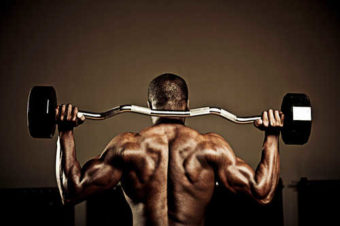
The bench press
Where else to start but the bench press? This friend of all serious weight lifters is also the cause of the great majority of shoulder injuries. Done right it is not only a chest developer but great for shoulders and triceps, but to avoid problems you must pay attention to the form. The safest method starts with a good set up. Pressing your upper back into the bench you want to pull your shoulders back and down away from your ears like you’re in some imaginary army parade line – only lying down. Take a grip on the bar about 1.5 shoulder widths wide and get someone to help un-rack the bar. In a controlled fashion bring the bar down to your lower chest keeping your forearms under the bar and upper arms at 45 degrees to the line of your body. You then press the bar up fast still keeping those shoulders away from your ears. You should aim to get the bar to your chest; aim for the greatest range of motion. Bouncing off the chest and a short range of motion are symptoms of problems. The second mistake is not setting up properly. I’ll say it now; the only place for the feet is on the floor, not on the bench. After your feet are planted, concentrate on shoulder blades. Pulling them down and back increases the stability of the torso on the bench and safeguards shoulders.
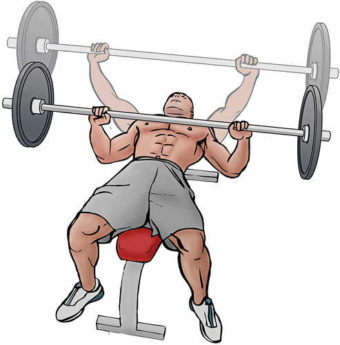
The squat
Nothing develops leg strength and size like the squat. A big squat is useful and impressive and it’s a shame than most people do them wrongly. Stand feet shoulder-width apart, with the toes pointed slightly out. The bar should be across your traps but not high on your shoulders or neck. Squat down with your weight on your heels while trying to keep the torso fairly upright, and your lower back nice and concave. It’s important to have the feeling of sitting down between your heels. Once you have got down as far as flexibility will allow drive all the way up using hips and thighs. It’s very common to see people loading the bar too heavy and not squatting down far enough. Squat as far down as you can without rounding your back, you should aim to get your thigh parallel with the floor or below. The secret is to develop flexible hips – deep unloaded squats and stretches will help here. The second problem you see is the failure to keep the chest high, if you don’t do this you’ll fold over. Keep looking forward and a little up by focusing on pushing your chest out and up. Finally work on your base; aim to keep the ankles from rolling in and the knees moving in a line over the toes. Often this can be helped by squatting in shoes with solid soles.
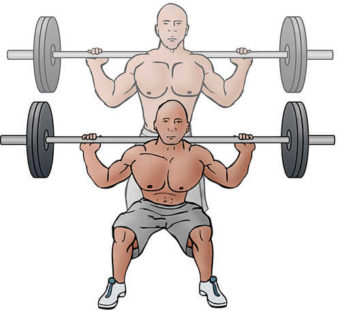
The deadlift
The dead lift trains virtually all the muscle on the back of your body as well as abdominal and quads. This is the exercise where you can use the most weight and train the most muscles – building real world strength adding all over muscle mass. Stand front and centre of the bar with your feet shoulder-width apart, feet pointing forward, with the bar running over the mid point of each foot. Bending forward and down at both the knees and the hips, grip the bar a few inches either side of your feet. At this point your shoulders should be over the bar, your back straight and your shins touching the bar. Breathe in, hold the breath and stand up by pushing your hips forward and dragging the bar up your shins. Lower the bar straight down to the floor. That’s one rep. Pause, breathe out and check your position and go again. I hear back pain excuses or worries about back health a lot. Deadlifts are safe if you are healthy, if not work on your back health and then do some deadlifts. Not only will your physique reap the rewards but so will your health and fitness into old age. What will give you a bad back, though, is lifting with a rounded back and arching back. Keep that back flat – all the way through the lift.
